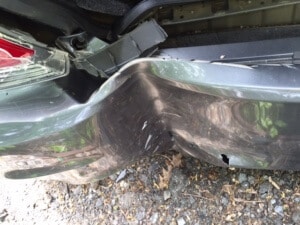
There is no shortage of ways for you to get injured while driving a vehicle, and rear-end accidents are the most common of them all. A rear-end collision occurs when one vehicle strikes another car from behind. Unfortunately, many people fail to realize the potential dangers of rear-end collisions because they seem “less severe” than massive 10-car pileups. In reality, rear-end collisions are not only the most common type of car accident, but they also cause more injuries to unsuspecting drivers than any other type of collision.
While being involved in a rear-end collision is undesirable, there is one positive aspect to these incidents. Maryland law clearly states that the rear-ending driver, or the person who strikes the other vehicle from behind, is responsible for the property damage and injuries that result from the crash. However, you can still be denied compensation if you do not seek legal help from an experienced car accident attorney. By working with a team of attorneys, you can not only enhance your odds of winning in court, but increase your potential compensation.
Every rear-end collision case is different in its own way. Here is a brief overview of the causes and aftermath of rear-end collisions, and why it’s so important to find an experienced car accident attorney.



Rear-end collisions may seem to be pretty “cut and dry,” but they can actually be quite complex due to the wide variety of causes for these incidents. Generally speaking, a rear-end collision occurs when a driver is trailing too closely behind a vehicle in front of them on the road. This dangerous habit, colloquially referred to as “tailgating,” is responsible for the vast majority of rear-end collisions. However, it’s worth noting that about 75% of all rear-end crashes involve a car that is in the process of stopping or has already completely stopped. While tailgating is always dangerous, the odds of a rear-end collision increase when drivers get too close to a vehicle in front of them as they approach a stoplight or intersection.
Rear-end collisions can also occur on an expressway at high speeds, though these situations are much more serious and often result in the death of one or more drivers. In most cases, rear-end collisions occur at low to medium speeds, but that doesn’t change the fact that they can be absolutely devastating. One of the worst times for rear-end collisions each year is at the beginning of winter in cold weather states. Often times, road authorities are not prepared with plows and salt trucks, which can lead to slick conditions. It is particularly important to maintain a safe distance behind vehicles when conditions worsen due to snow or ice. You should maintain a three second gap between your vehicle and the car in front of you in normal conditions, but this distance should increase to five seconds or more depending on how poor the roads are during a storm.
Rear-end collisions are commonly seen as “two-car” incidents, but the momentum from a stricken vehicle can often carry into other cars on the road. Therefore, it is important to start documenting the incident immediately after the situation settles down to avoid conflicting stories. Your duties obviously change depending on how injured you are, but it is crucial to help your car accident attorney by starting the discovery process as soon as possible. This could involve identifying witnesses to wait with you at the scene of the crash so they can give police their account of the accident. You also need to take pictures of any property damage that you may have incurred, in addition to obtaining the personal information of the other parties involved in the crash.
Another common misconception of rear-end collisions is that they are “not serious.” The most common injury resulting from these types of accidents is whiplash, which entails any sudden jarring of your head and neck. There is a wide array of injuries that are associated with whiplash, including but not limited to: concussions, dizziness, severe neck pain, neck stiffness, muscle strains, nerve damage, and spine injuries. More often than not, these injuries do not become apparent until you have left the scene of the accident. They may not even present themselves until several days after the crash. You absolutely need to document the entire incident and seek immediate medical attention following every rear-end collision, regardless of how you feel at the time.
You can do everything in your power on the road to be a safe driver, but unfortunately, you cannot control the actions of other drivers. If you or a loved one is involved in a rear-end accident, you need to get in touch with an experienced car accident attorney as soon as possible, particularly if your vehicle was struck from behind. The injuries that result from these accidents can linger for years, or even the rest of your life in some cases. This pain and suffering can deter you from living life to the fullest, in addition to rendering you unable to work and support your family.
A trusted car accident attorney can examine every aspect of your case to ensure that you receive maximum possible compensation for your troubles. Since Maryland has its own specific laws relative to these cases, you need a car accident attorney with years of experience in fighting for Maryland clients just like you. A rear-end collision is certainly a setback, but you deserve a car accident attorney who will take a personal interest in your case and fight for the best result possible. Contact DuBoff & Associates, Chartered today to get started.
Filed Under:
Comments are closed.